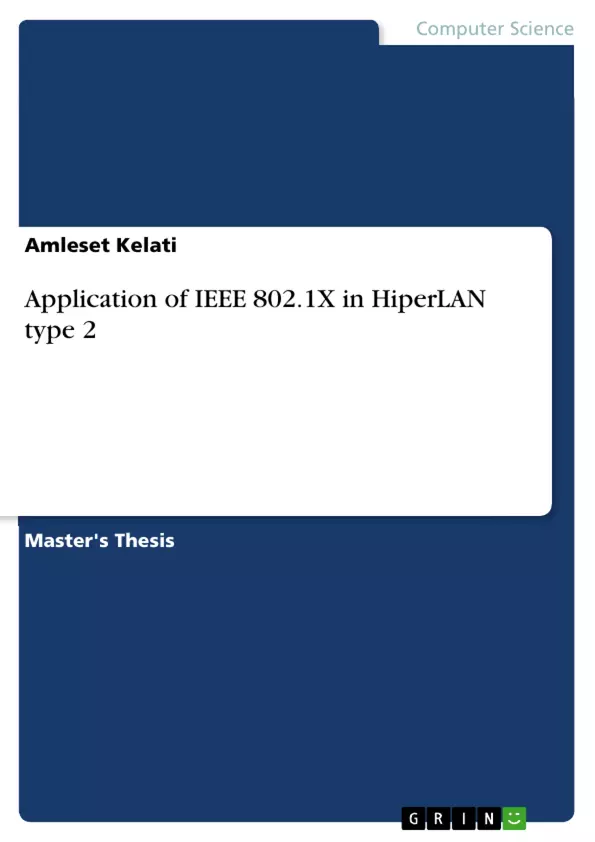The research within Information Technology has been subject to a tremendous speed-up in the latest years, mainly due to the reduced prices of the related technology and, consequently, to a strongly increased interest of the users. This causes a positive feedback loop, since many companies decide to invest more money in such area, reducing further the prices and accelerating this process.
One of the major issues in this big race has been the concept “Be connected always and everywhere”, which translated in an increased development of public networks on one side and in a further growth of big corporation networks on the other side. The common factors of these big areas are mobility, which implies wireless networks, and availability of services, which also means access to more or less important information.
Increased size, mobility and availability of services on networks that become bigger and bigger increases tremendously the importance of data-security. Trust, authentication, and authorization have become vital key words within the design of big, mobile networks.
IEEE 802.1X, also known as “Port Based Network Access Control” is a means for providing authentication and authorization for big networks that offer the possibility to many devices to attach to them, making their services available.
Table of Contents
- Part 1: Description of IEEE 802.1X and Related Protocols
- Part 2: Methodology and Results of IEEE 802.1X Integration with HIPERLAN/2
- Part 3: Prototype Implementation, Limitations, and Further Work
Objectives and Key Themes
The primary objective of this master's thesis was to investigate the IEEE 802.1X authentication and authorization standard and its integration into the HIPERLAN type 2 wireless LAN standard. The research aimed to analyze existing standards and related protocols, develop a solution for implementation, and create and test a basic prototype.
- Integration of IEEE 802.1X into HIPERLAN/2
- Analysis of IEEE 802.1X and related security protocols
- Design and development of a prototype implementation
- Testing and evaluation of the prototype
- Assessment of limitations and future work
Chapter Summaries
Part 1: Description of IEEE 802.1X and Related Protocols: This section provides a detailed overview of the IEEE 802.1X standard, also known as Port Based Network Access Control. It explains how this standard enhances security in large networks by providing authentication and authorization mechanisms. The chapter likely delves into the functionality of 802.1X, its components (such as the Supplicant, Authenticator, and Authentication Server), and how it operates within a typical LAN environment. It also likely discusses other related protocols that contribute to overall network security and interoperability with IEEE 802.1X.
Part 2: Methodology and Results of IEEE 802.1X Integration with HIPERLAN/2: This part outlines the methodology employed to integrate IEEE 802.1X with HIPERLAN/2. It details the approach taken to adapt features of both standards and the rationale behind the chosen architecture. The summary of this section would likely highlight the challenges encountered during integration, the solutions implemented, and a presentation of the results obtained. This might include discussions about modifications to the standards, compatibility issues, and the effectiveness of the integration process. The focus would be on the overall strategy and the successful integration, not the minutiae of individual steps.
Part 3: Prototype Implementation, Limitations, and Further Work: This section describes the implemented prototype, focusing on its design, functionality, and testing results. The limitations of the prototype are discussed, highlighting areas where the system falls short of a fully functional, production-ready solution. Crucially, this section would also outline potential future work, identifying improvements or extensions needed to make the prototype suitable for real-world applications in professional settings. This would involve recommendations for enhancements to robustness, scalability, and security.
Keywords
IEEE 802.1X, HIPERLAN/2, network security, authentication, authorization, wireless LAN, port-based network access control, prototype implementation, security protocols.
IEEE 802.1X and HIPERLAN/2 Integration: Master's Thesis Overview
What is the main topic of this master's thesis?
The thesis investigates the integration of the IEEE 802.1X authentication and authorization standard into the HIPERLAN/2 wireless LAN standard. It aims to analyze existing standards, develop an implementation solution, and create and test a prototype.
What are the key themes explored in the thesis?
Key themes include the integration of IEEE 802.1X into HIPERLAN/2, analysis of IEEE 802.1X and related security protocols, design and development of a prototype implementation, testing and evaluation of the prototype, and assessment of limitations and future work.
What are the different parts of the thesis?
The thesis is divided into three parts: Part 1 describes IEEE 802.1X and related protocols; Part 2 details the methodology and results of integrating IEEE 802.1X with HIPERLAN/2; and Part 3 covers the prototype implementation, its limitations, and suggestions for future work.
What does Part 1 cover?
Part 1 provides a comprehensive overview of the IEEE 802.1X standard (Port Based Network Access Control), explaining its functionality, components (Supplicant, Authenticator, Authentication Server), and operation within a LAN environment. It also discusses related security protocols.
What does Part 2 cover?
Part 2 outlines the methodology used to integrate IEEE 802.1X with HIPERLAN/2, detailing the approach, challenges encountered, solutions implemented, and the results obtained. It focuses on the integration strategy and its effectiveness.
What does Part 3 cover?
Part 3 describes the implemented prototype, its design, functionality, and testing results. It analyzes the prototype's limitations and suggests future work, including improvements to robustness, scalability, and security for real-world applications.
What are the keywords associated with this thesis?
Keywords include IEEE 802.1X, HIPERLAN/2, network security, authentication, authorization, wireless LAN, port-based network access control, prototype implementation, and security protocols.
What is the overall objective of the thesis?
The primary objective is to successfully integrate IEEE 802.1X into HIPERLAN/2, demonstrating a functional prototype and highlighting potential areas for improvement and future research.
What is the target audience for this thesis?
This thesis is intended for academic use, focusing on the analysis of themes related to network security and wireless LAN technologies.
- Citar trabajo
- Amleset Kelati (Autor), 2001, Application of IEEE 802.1X in HiperLAN type 2, Múnich, GRIN Verlag, https://www.grin.com/document/323219



